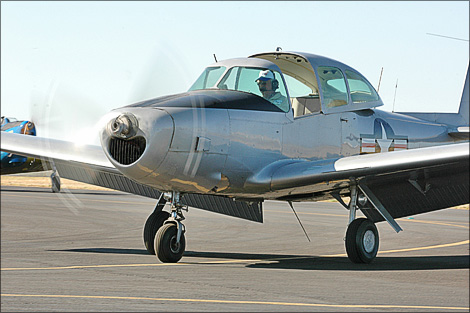|

Photo by Max Haynes -
MaxAir2Air.com
History: As the German air
industry was throttled back by the Versailles Treaty after W.W.I, so was the American
aviation industry reduced by the cessation of hostilities and the misreading of the
American private aircraft potential after WWII. Returning GI's either had no interest in
flying because of their combat experiences, or couldn't afford aircraft as they tried to
resume their lives, get an education, buy homes, and so on. Thus, while many aircraft
manufacturers converted their assembly lines to new or revived civilian lines, the well of
purchasers ran dry within a few years of war's end. If North American Aviation was
different, it was a matter of degree, not kind. When WWII ended, the North American
production facilities that had been pumping out P-51 Mustangs, B-25 Mitchell bombers and
T-6 Texan trainers were suddenly pumping nothing, which North American quickly changed by
activating the four-place 185hp NA-145 "Navion"
monoplane design for the civilian market.
With 1,109 built during 1946-47, the plane was initially highly successful, even
attracting the interest of the United States Army Air Force, for which a prototype,
designated L-17, was developed in 1946. In production, 83 of the
craft, designated L-17A, were manufactured that year as liaison
aircraft, personnel/cargo carriers, and as trainers with the university-based Reserve
Officers Training Corps flight training program. Six of the aircraft were used as target
drones.
Ryan Aeronautical Company acquired the design and manufacturing rights for the Navion and
sold an additional 158 L-17Bs (a new and improved version of the
design) to the newly established United States Air Force. These were delivered to the USAF
in 1948, and five more were ordered in 1949 when production of the L-17 ended. Thirty-five
of the A models were subsequently upgraded into L-17Cs via
improvements to the brakes and an expansion of the plane's fuel capacity.
When the all-service renaming of aircraft took place in 1962, surviving L-17s were
re-designated U-18. The Navion was retired from active service
shortly thereafter, some surviving to the present as civilian aircraft. Counting the
military products, Ryan manufactured 1,240 Navions between 1949-51.
The Navion was then dormant from 1951 until 1957, until Tubular Service and Engineering
Co. (TUSCO) acquired the design and tooling from Ryan. TUSCO upgraded the powerplant
options for new and existing Navions, designing speed and efficiency options in Navion
models D, E and F. TUSCO also designed and produced about 120 of a Navion
Model H variation, the Rangemaster, which replaced
the sliding canopy entry with a cabin door. True to its name, the Rangemaster also had a
significantly enlarged fuel capacity that increased its range to more than 1800 miles from
the original 700 mile range of the Navion.
This brought the total number of Navions manufactured until 1964 to 2,469, with
about 246 of that total being L-17s.
After TUSCO, the Navion passed though various corporate hands, with another 50-60
of the "Rangemaster" 285 hp models produced between 1964 and 1976. In
2003, Sierra Hotel Aero, Inc. of South St. Paul, Minnesota, USA, acquired
the type certificate, tooling and a substantial manufacturing parts
inventory, and in 2013 claimed to be working toward bringing the aircraft
back to production.
Nicknames: The "Poor Man's
Mustang"
Specifications (L-17A):
Engine: One 185-hp Continental O-470-7 piston engine
Weight: Empty 1,945 lbs., Max
Takeoff 2,950 lbs.
Wing Span: 33ft. 5in.
Length: 27ft. 6in.
Height: 8ft. 7in.
Performance:
Maximum Speed:
163 mph
Ceiling: 17,000
ft.
Range: 700 miles
Armament: None
Number Built: 2,469 Navions
(Approximately 246 built as military L-17s.)
Number Still Airworthy: Unknown
 [ Flight Report by Budd
Davisson ] [ Flight Report by Budd
Davisson ]
Links:
AeroWeb L-17 Page
American Navion
Society ("Navioneers")
Johnny Rister's Place -- Navion
photos
L-17.org --
"Preserving Navion military heritage"
Navion Aircraft, International --
The Navion factory and
type certificate holder.
Navion Pilots Association --
Organization of Navion owners, pilots, mechanics and enthusiasts.
Navion Skies --
Service manuals, parts manuals and technical information about Navions.
Sierra Hotel Aero -- Navion support
and STCs.
Southern Navion Air
Group (SNAG) -- Navion owners and pilot's group.
TwinNavion.com -- Information about
the twin-engine Navion.
Warbird Video Navion page
Books: Browse a
selection of books about liaison aircraft.

[Back to Warbird Alley's Main
Page]
All text and photos Copyright 2016 The Doublestar Group, unless otherwise noted.
You may use this page for your own, non-commercial reference purposes only.
 |